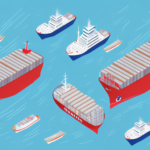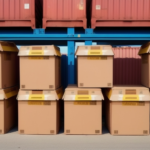A Comprehensive Shipping Glossary for Beginners
Shipping can seem like an overwhelming and complex process, especially for beginners. With a myriad of terminology, procedures, and regulations to navigate, understanding how shipping works can be challenging. This detailed glossary provides in-depth explanations of shipping terminology, procedures, and best practices to help you streamline your shipping operations and maximize efficiency.
Understanding the Basics of Shipping Terminology
Before delving deeper into the world of shipping, it's essential to familiarize yourself with basic terminology. Terms like freight, cargo, and shipment are often used interchangeably but have distinct meanings:
- Freight refers to any goods transported by air, sea, or land.
- Cargo is a specific type of freight transported by a ship or aircraft.
- Shipment refers to a specific consignment of goods being transported from one place to another.
Another important term is Incoterms, a set of standardized rules defining the responsibilities of buyers and sellers in international trade. These rules determine who is responsible for the cost and risk of transporting goods and the point at which ownership transfers from seller to buyer. For a detailed overview of Incoterms, refer to the International Chamber of Commerce's Incoterms 2020.
Modes of Transportation in Shipping
Understanding the different modes of transportation is crucial for selecting the most efficient and cost-effective method for your shipping needs:
- Air Freight: The fastest mode of transportation, ideal for time-sensitive and high-value goods, but also the most expensive.
- Sea Freight: Slower but more cost-effective for transporting large or bulky quantities of goods. Suitable for non-perishable items.
- Road Transportation: Commonly used for domestic shipping, offering flexibility and reliability for shorter distances.
- Rail Transportation: An efficient option for moving large volumes of goods over land, particularly for intercontinental shipments.
According to the International Transport Forum, sea freight accounts for over 80% of global trade by volume, highlighting its significance in the shipping industry (source: ITF Overview of Logistics Performance).
Types of Shipping: A Comparison
When choosing a shipping method, consider factors such as speed, cost, and the nature of the goods:
- Air Shipping: Best for perishable items like food or flowers, ensuring freshness and reducing the risk of damage.
- Sea Shipping: Ideal for bulky or heavy items, offering significant cost savings over air freight.
- Land Shipping: Suitable for domestic or regional deliveries, providing flexibility and quicker transit times compared to sea freight.
Additionally, sustainability is increasingly critical. Air transportation has a higher carbon footprint compared to sea or land options. Businesses prioritizing sustainability may opt for more eco-friendly shipping methods, such as sea freight or rail transportation, to reduce their environmental impact.
The Role of Freight Forwarders in Shipping
Freight forwarders are vital in facilitating the transportation of goods from one location to another. Acting as intermediaries between shippers and carriers, they manage logistics, documentation, and customs clearance. For more information on the role of freight forwarders, see the Investopedia freight forwarder definition.
Moreover, freight forwarders ensure the safe and secure transport of goods by arranging appropriate packaging, labeling, and insurance coverage. In case of delays or damages, they work with carriers and shippers to resolve issues and minimize losses.
Shipping Documents: A Beginner's Guide
Shipping involves extensive paperwork, which is critical for smooth operations and compliance with regulations. Essential shipping documents include:
- Bill of Lading: A legal document between the shipper and carrier detailing the type, quantity, and destination of the goods.
- Commercial Invoice: An itemized list of goods being shipped, including prices and terms of sale.
- Packing List: Provides details on how goods are packed, including dimensions and weight.
- Customs Declaration Form: A form required by customs authorities to determine taxes and duties on imported goods.
Different countries have varying requirements for shipping documents, and additional permits or certificates may be necessary for certain types of goods. It's essential to research and understand the specific requirements for your destination country to avoid delays and penalties. Keeping copies of all shipping documents is recommended for record-keeping and ensuring smooth customs clearance.
Common Challenges Faced in International Shipping
International shipping presents unique challenges, such as:
- Language Barriers and Cultural Differences: Miscommunications can lead to errors in documentation and processes.
- Varying Regulations: Each country has its own set of regulations, requiring thorough understanding and compliance to avoid fines and delays.
- Logistics Planning: Coordinating the movement of goods across borders involves selecting appropriate transportation modes, reliable carriers, and managing unforeseen factors like weather or political instability.
Effective planning and working with experienced logistics providers can help mitigate these challenges.
Choosing the Right Shipping Method for Your Business
Selecting an appropriate shipping method depends on several factors:
- Cost: Balancing budget constraints with shipping needs.
- Speed: Determining the required delivery timeline for your goods.
- Type of Products: Considering the nature of the goods, such as perishability or value.
- Destination: Ensuring the carrier has experience with the destination's regulations and can provide reliable tracking and insurance.
Communicating clearly with customers about available shipping options and associated costs can enhance customer satisfaction and competitiveness.
Top Tips for Efficient and Cost-Effective Shipping
To maximize efficiency and minimize costs in shipping:
- Consolidate Shipments: Combining multiple shipments can reduce costs and streamline logistics.
- Negotiate Rates: Working with carriers to secure favorable rates based on volume and frequency.
- Optimize Packaging: Using appropriate packaging materials to reduce waste and prevent damage.
- Leverage Shipping Software: Utilizing advanced shipping software and automation tools can streamline processes, reduce errors, and save time. For more on shipping software options, see Flexport's guide to shipping software.
- Monitor Shipments in Real-Time: Real-time tracking helps identify and resolve issues promptly.
- Adopt Eco-Friendly Practices: Using recycled materials and choosing sustainable shipping methods can reduce your carbon footprint and potentially lower costs in the long run.
Understanding Customs Clearance Procedures
Customs clearance involves inspections and assessments by customs authorities to ensure imported goods comply with regulations. The process can be time-consuming and costly, but partnering with a reliable freight forwarder can expedite procedures and ensure compliance.
Customs procedures vary by country and depend on factors like the type of goods, their value, and origin. Certain goods, like hazardous materials or food products, may require additional documentation or inspections. Staying informed about the latest regulations and requirements is essential to avoid delays or penalties.
The Future of the Shipping Industry: Trends and Technologies to Watch
The shipping industry is continually evolving with emerging trends and technologies, including:
- Blockchain: Enhancing transparency and security in shipping transactions.
- Automation: Improving efficiency through automated processes and operations.
- Artificial Intelligence: Optimizing routes, predicting maintenance needs, and enhancing decision-making.
- Internet of Things (IoT): Connecting devices and sensors on ships and cargo to gather real-time data for optimized operations and safety improvements.
- Eco-Friendly Practices: Increasing focus on sustainability with alternative fuels, energy-efficient vessels, and carbon footprint reduction strategies.
These advancements have the potential to revolutionize the shipping industry by improving transparency, efficiency, and sustainability. For instance, the adoption of IoT in shipping enables real-time tracking and monitoring, leading to better route optimization and reduced operational costs (ScienceDirect on IoT in Shipping).
How to Track Your Shipment and Ensure Safe Delivery
Tracking your shipment is essential for timely delivery and minimizing the risk of loss or damage. Most carriers offer online tracking services, allowing you to monitor your shipment's status in real-time. To ensure safe delivery:
- Proper Packaging: Ensure goods are adequately packed to prevent damage during transit.
- Accurate Delivery Address: Double-check the address details before shipping to avoid delays or misdeliveries.
- Insurance Coverage: Opt for insurance to protect against unforeseen circumstances during transit.
Using advanced tracking systems provided by carriers can help you stay informed and respond quickly to any issues that arise during shipping.
Importance of Packaging in Safe Shipping
Proper packaging is crucial for protecting goods during transportation. Effective packaging ensures that products remain secure and undamaged throughout the shipping process. Key considerations include:
- Securing and Cushioning: Use appropriate materials to secure and cushion the goods.
- Labeling: Clearly label packages with relevant information, including handling instructions for fragile items.
- Material Selection: Choose packaging materials based on the specific needs of the shipment. For example, perishable goods may require insulated packaging.
Investing in quality packaging materials and methods can significantly reduce the risk of damage and returns, enhancing customer satisfaction.
Common Mistakes to Avoid in Shipping
Avoid common pitfalls in shipping to ensure smooth operations and maintain a good reputation:
- Incorrect Labeling: Ensure all packages are correctly labeled with accurate information to prevent misdeliveries.
- Inadequate Packaging: Use appropriate packaging materials to protect goods from damage.
- Incomplete Documentation: Provide all necessary documentation to avoid delays and penalties at customs.
By addressing these common mistakes, businesses can improve their shipping processes and enhance overall efficiency.
Navigating the Legalities of International Shipping
International shipping is subject to various laws and regulations, including trade laws, customs regulations, and insurance requirements. Compliance is essential to avoid legal complications and financial penalties. Key aspects include:
- Trade Compliance: Adhere to trade agreements and regulations of both exporting and importing countries.
- Customs Regulations: Ensure all shipments meet the customs requirements of the destination country.
- Insurance Requirements: Understand the necessary insurance coverage for your shipments to protect against potential losses.
Staying informed about changes in international shipping laws and regulations is crucial for maintaining compliance and smooth operations.
Essential Tools and Resources for Successful Shipping
To ensure successful shipping operations, utilize various tools and resources that streamline processes and ensure compliance:
- Freight Calculators: Estimate shipping costs based on weight, dimensions, and destination.
- Trade Compliance Software: Manage and automate compliance with international shipping regulations.
- Customs Brokers: Professionals who assist with customs clearance and documentation.
Leveraging these tools and resources can enhance efficiency, reduce costs, and ensure successful shipping operations. For example, Flexport offers comprehensive shipping solutions that integrate technology and logistics expertise.
Shipping is a complex process, but with a solid understanding of the terminology, procedures, and best practices, beginners can navigate it with confidence. By utilizing the resources and strategies outlined in this comprehensive shipping glossary, businesses can streamline their operations, reduce costs, and maximize efficiency.




















